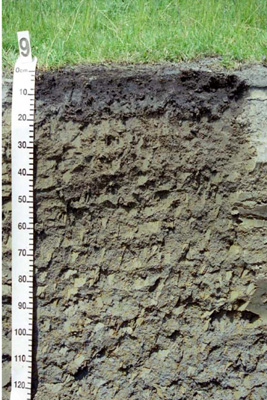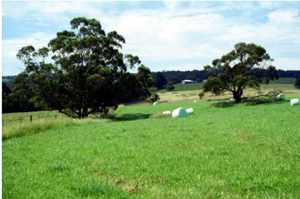CLRA10
|
| CLRA10 |  | |
| Kennedys Creek (Lavers Hill Cobden Road), Otway Ranges, south-west Victoria | |||
| Low hills | |||
| Neogene Gellibrand Marl: marine silty clay, clayey silt, calcareous, minor calcarenite | |||
| Lower slope | |||
| 5% | |||
| North | |||
Horizon | Depth (cm) | Description | ||
A1 | 0–10 | Very dark greyish brown (10YR3/2); clay loam; weak granular structure; weak dry consistence; pH 6.0; clear smooth boundary to: | ||
B1 | 10–30 | Greyish brown (2.5Y5/2) and light grey (2.5Y7/1 dry) with many fine distinct brownish yellow (10YR6/6) mottles due to bioturbation; clay loam; weak coarse blocky parting to medium blocky structure; smooth and rough ped fabric; weak consistence (moderately moist); pH 5.5; clear smooth boundary to: | ||
B21 | 30–55 | Light olive brown (2.5Y5/3); light clay; weak coarse blocky structure; smooth and rough ped fabric; weak consistence (moderately moist); pH 5.5; clear smooth boundary to: | ||
B22 | 55–85 | Greyish brown (2.5Y5/2) with common medium prominent brownish yellow (10YR6/8) mottles; medium clay; weak coarse blocky structure; smooth and rough ped fabric; firm consistence (moist); pH 5.5; clear smooth boundary to: | ||
B23 | 85–115+ | Grey (2.5Y6/1) with common medium prominent brownish yellow (10YR6/8) mottles; medium clay; strong medium polyhedral parting to fine lenticular structure; smooth ped fabric; firm consistence (moist); pH 5.5. | ||
| Management considerations | ||||
| This soil is gradational with limited texture change with depth but clear horizon boundaries. The weak structure contributes to the imperfect drainage of the soils as evidenced by subsoil mottling and colour. Other influences on drainage include rainfall and topographic position; here on a lower slope receiving moisture from upslope. Fine sand is a dominant component of this soil but the soil is quite stable (Emerson class 5 for subsoil) though a little less so for the B1horizon (Emerson class 3(1) for subsoil). The high organic matter content of the surface (8.4% OM) and subsurface soil (1.6% OM) aids stability. The surface soil is limited in depth and therefore restricting as a seedbed. The lower pH in the subsoil will restrict the availability of some nutrients (less calcium) and increase the availability and mobility of aluminium, while the higher surface pH is a result of management intervention to improve nutrient availability. It would seem that the B1 is becoming an eluviated horizon with less clay than above and below and is the most erosion prone. | ||||
Analytical data
Site CLRA10 | Sample depth | pH | EC | NaCl | Ex Ca | Ex Mg | Ex K | Ex Na | Ex Al | Ex Acidity | FC –10kPa | PWP –1500kPa | KS | FS | Z | C | |
Horizon | cm | H2O | CaCl2 | dS/m | % | cmolc/kg | cmolc/kg | cmolc/kg | cmolc/kg | mg/kg | cmolc/kg | % | % | % | % | % | % |
A1 | 0–10 | 6.5 | 6.3 | 0.29 | <0.01 | 12 | 1.5 | 0.2 | 0.1 | 11 | 13 | 42.8 | 13.8 | 5.2 | 46.4 | 8.5 | 29.5 |
B1 | 20–30 | 5.7 | 5 | 0.07 | N/R | 4.8 | 1.7 | 0.25 | 0.27 | 61 | 8.2 | 31.9 | 10.1 | 0.5 | 50.8 | 25.5 | 23 |
B21 | 35–50 | 5.3 | 4.4 | 0.06 | N/R | 2.5 | 3.2 | 0.29 | 0.36 | 220 | 8.8 | 33.4 | 15.7 | 0.2 | 43.4 | 22.5 | 31.5 |
B22 | 65–80 | 5.3 | 4.4 | 0.08 | N/R | 1.5 | 4 | 0.26 | 0.49 | 250 | 8.5 | 34.3 | 7.9 | 0.1 | 41.4 | 19 | 37.5 |
B23 | 85–100 | 5.2 | 4.2 | 0.08 | N/R | 0.92 | 4 | 0.24 | 0.7 | N/R | N/R | N/R | N/R | N/R | N/R | N/R | N/R |



